People with diabetes should have their feet checked at least once a year.
Foot complications are relatively common, with foot ulcers alone affecting up to 1 in 10 people with diabetes, and need to be treated quickly to prevent them becoming even more serious.
What is a foot examination for?
Diabetes can affect the nerves as well as blood circulation which are both important to our feet.
Blisters, burns and cuts are all possible and if you suffer from nerve damage you may not feel the pain.
It may not be easy to spot nerve damage as it comes on very gradually; this is partly why a foot examination once a year is important.
Blood circulation needs to be checked as good circulation is needed to keep your feet healthy; from the nerves and muscles inside to the skin outside.
How often should I have a foot examination?
People with diabetes should have a foot examination at least once a year.
Note that it is very important that you check your own feet on a daily basis as well, as foot problems can quickly become serious. If you notice any changes or damage to your feet, notify your doctor and either your doctor or podiatrist can then assess and treat the problem.
What happens at a foot examination?
The foot examination may be carried out by a diabetic consultant, a GP , a podiatrist or a nurse.
The examiner will often ask you a few questions about your diabetes control, your feet or another health condition which may be directly related.
You will be asked to take off your shoes and socks so the examiner can carry out some tests on your feet.
Testing the feeling in your feet
The examiner will touch a number of your toes and sometimes other parts of the foot to test whether your nerves are detecting the feeling.
The examiner will use a small plastic instrument (monofilament), a biothesiometer or a calibrated tuning fork to do this.
Testing for blood circulation
The examiner may test the pulse in your feet and may check the blood pressure in your legs as well.
Your feet will also be checked to see if there is any damage to the feet such as:
- Cuts
- Burns
- Blisters
- Corns
- Calluses
- Any problems with the nails
If there is, they will either be able to advise how best to treat them or you may be referred to a podiatrist.
Caring for your feet
It is important to regularly check your feet, ideally each day, for any signs of damage to the feet which can include cuts, burns, blisters, bruises or changes in colour. If you notice signs of damage to your feet, contact your health team who can advise you of any treatment or care you may need to apply.
Find out more about diabetes and foot care






